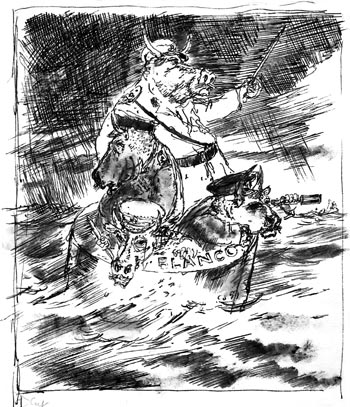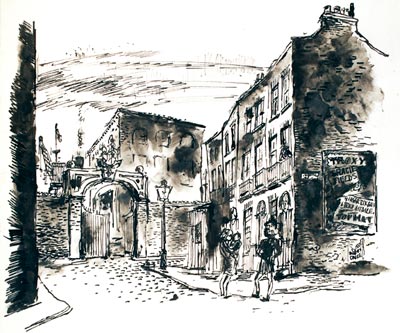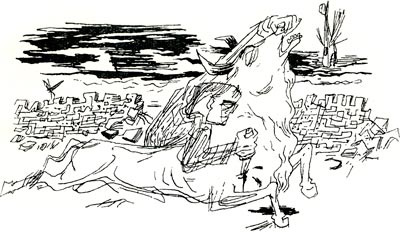James Boswell: Artist Against Fascism
James Boswell first showed me his three army sketchbooks in 1941 — in, I think, the July, since I was myself in the Army by September. He had only been called up in January, so the drawings were then very fresh, the pages by no means as crowded as they were to become after four more years of service (their present state). They astounded me then, and still do.

Great Bull officers float awash on blocks of Blanco; Others hold stethoscopes to the chests of ordinary mortal men; others ride horseback on exhausted conscripts; one waters a War Department sand-bucket to cultivate the soldiers skeleton growing from it; another, a-top a heap of rubble and human limbs types Company Orders which fly away by the flock across the sky; others turn chaplain and ram a stone crucifix down a soldier’s throat; elsewhere victims slither, collapse and are like to drown. Swamped in Bullshit. A lot of the drawings, but not all, describe this bestiary. There are also portraits of fellow squaddies, army nissenscapes, literal hut interiors, occasional set-pieces — I particularly recall a happy and murderous free-for-all called “Nursing Orderlies at Play”- more portraits, one (as I believe) a self-portrait.
However, to suggest that the sketchbooks present two styles would be wrong. Those vast incontinent Bulls inhabit this identical reality: the ordinary mortals whose chests are being examined, who slither, or lie dismembered, or are force-fed religion, are precisely the figures of the portraits and hut scenes Moreover, Boz has been at enormous pains to make the Bulls themselves pretend humanity. The one typing has a romantic’s dreaming look so that his Orders might almost be poems; the one watering a skeleton seems neighbourly, a garden-lover, enormously considerate of his plant; in their “mess” these Bulls are shortsighted or attend to such mortal foibles as crossword puzzles. Not to fight fascism whole-heartedly is sub-human, but bestiality wears a human face. The effect is awesome.
That first meeting with Boz was at the offices of Our Time where I was a mere student awaiting call-up, but a student who had cut his political eye teeth on the Left Review cartoons of all three Jameses - Fitton and Holland as well as Boswell - and upon Boz’s more documentary drawings of 1930: immiseration. And here he was: big, ambling, bearlike in khaki and yet, despite a certain dangerous glint in the eye, thoroughly amiable. Myself apart he was, after all, among old friends. So far as call-up and the dispersals and deaths of war allowed, by and large his colleagues of Left Review had become the Our Time team. But they were as astounded as I by the sketchbooks: I now think, looking back, precisely because what had once seemed two sorts of drawing were now united in one.
Characteristically the line of the Left Review cartoons is very sharp and unequivocal. Shading is virtually non-existent, there is none of that one-time cartoonists standby, the mechanical tint, shadows are few and solid and the drawing consequently spacious. Because large areas of paper remain un-marked the black-and-white, in which a cartoonist for newsprint necessarily works is very black. very white. It shouts. All the cartoons I can recall were concerned with the violence of that motive called Profit: even behind simple anti-fascisms lurked “the City”. Human eyes are reduced to pinpoint. mouths are almost invariably clamped, bodies are bloated, corsetted or in final collapse. That’s to say, everything has reached a sort of rigor mortis that will not change. There is no possible ambiguity about what is animal, what human. Simplified thus, it seems in retrospect an easy step — though I don’t know anyone else who took it — to characters becoming visual symbols for what they are, do, represent. In this way the face of one of Boz’s generals becomes a machine-gun, a press baron’s face a megaphone. a bishop’s a crucifix with skull for skullcap.

But there is another characteristic Boswell drawing of the 1930s. This is crowded with natural observation and usually with people too, delights in the slightest difference between characters. occupies all the space and includes much graduated shading. If the particular drawing is not actually heaving with population, then it is as least concerned with population’s environment — streets, pintable halls, pub interiors, market places both indoors and out. Not infrequently an apparent Street-scape reveals, through one out of many windows, interior human drama. No space can be ignored, for life is everywhere, if you but look. Right through the 1930s drawings of this kind of actuality - for Kentish Town. Camden Town, Soho, the East End — abound, a kind that made his pupil and friend Paul Hogarth call him the 30s “eyewitness”.
One needs to be wary however of perceiving in two styles of drawing a divergence of view. In by far the most generous and perceptive article about his 1930’s work by one who was not there at the time, Richard Cork has referred to his “innate gentleness, which has also expressed itself...in surprisingly mellow drawings of street life far removed from the savagery of his Left Review illustrations”. But why surprise? Innate gentleness related to savagery as Cause to Effect — and not for Boz alone, though his pictures of both kinds became unique perhaps as the visual emblems for that whole movement in England against war, unemployment, poverty and the uncaringness of Art which drew so many towards anti-fascism and revolution, on from Pity to Action. As a kind of threnody through that other, literary emblem of those times, Rex Warner’s novel The Professor of 1938. there runs the phrase “I hate because I love”. The speaker might be Boz himself. Subsequent histories have superimposed on the Past, and for later reasons, something there is little evidence to believe was there: a doctrinaire rigidity and sameness of view, common to all on a monolithic Left devoid of individualities.
By his own account Boz’s first despair on reaching England from New Zealand in 1925 was to find painting so “dreary,academic and rubbishy”, and it was his attempts through the end of the 1920s to find more purposeful ways to paint that forced political partisanship upon him. As a New Zealander and heir to the slaughter of Gallipoli, War appalled him, as indeed it did all that generation; but so, increasingly, did a peace that seemed equally neglectful of livelihood and life. Before he had been in England a year the General Strike began. Like Montagu Slater, playwright and librettist, his close friend from the 1920’s and already a communist, Boz was moving steadily towards, and in 1932 eventually joined, the Communist Party. The two friends became active in Kentish Town, but neither exclusively so. Montagu worked with Benjamin Britten and others in writing pageants for the Co-op movement (and ultimately Peter Grimes), while Boswell helped form the Artists International Association in 1933 and exhibited extensively under its anti-fascist auspices |n1934 they were together professionally as editor-in-chief and art editor respectively of the newly-founded Left Review.
There may have been other ways for people to reach the same political destination: a philosophical route perhaps, or one — Malcolm Muggeridge was later to plead guilty to loitering on it — from which Russia appeared to be Utopia. But for Boswell, Slater and their kind the ways were the literal streets they knew. They continued to see poverty there and, as fascism spread. the threat of war. Their revulsion increased. Boz‘s Left Review drawing for Royal Jubilee year puts it precisely: skeletons of Hunger Marcher and First World War soldier stride across a BBC, a St Paul’s and a Parliament all bedecked with union jacks, while the legend “1910-1953” drips blood. “Innate tenderness” and “savagery” are inseparable.
Aesthetic theories do not spring readymade like horns from the brow, even supposing (as do some historians and other penitents, alas, than Muggeridge) that Boswell’s course was necessarily fiendish. or, as the slang goes, Stalinist. I can in fact think of no narrowly “party-line” or Russophile drawing by him, and precious little of the sort about either Left Review or Our Time, whatever History would like to suppose. Certainly when fascism came here to the streets he knew and loved, Boz drew it — in Cable Street in 1936. Certainly he followed wherever anti-fascism led, and worked for Spain in 1937 and 1938. There were jobs to do and you did them. His detailed recollections about the formation of the AIA describe its fourteen or so founders working as if at a perpetual conveyor belt of poster, banner and cartoon production. You used your skills in a Cause, that is, but also got on with your Art: two functions, one man. War service put that man on a different footing perhaps “Getting on with one’s Art” subsumed the propaganda. The two functions became one.
I did not meet Boz again until 1945, long after my own demobilisation and shortly before his own. The three sketchbooks were fuller now,and the Bulls had shed the uniforms of British officers, adopted myth and settled to raping Europa in drawings of incredible violence — done, I think, in Iraq, their violence partly a frustration at his distance from a fighting he wished won. But at this 1945 meeting he also produced one of those rich, populated drawings of his, called “No more asking for a pass”. A-burst with lovingly ribald observation, it showed soldiers picking the parts of their civvy suits from store, trying on Peace for size. This was again at the Our Time offices. where the editor was now that phenomenal poet Egell Rickword, another old friend from Left Review. “Are you going to lithograph it?” Edgell asked of the drawing, to which Boz replied, “Why? Have we some demo coming up?” Proceeding to the pub, as Our Time always did, this otherwise obscure exchange was explained to me as referring to Boz’s 1930s habit of lithographing whatever “populated” drawing of his took his fancy for sale on the next day’s anti-fascist march — for International Brigade, for Unemployed, for Peace. The explanation was protracted of course. As usual Boz was chiefly observing and drawing our fellow-boozers in yet another sketch book.
“No more asking for a pass” became not a lithograph — there were indeed no demos — but the cover drawing for the January 1946 Our Time. Not untypically Boz saw to it that the February and March covers were by the other two Jameses. Holland and Fitton respectively. We were all agreed. Just as war against fascism had succeeded as peace against fascism, so the new Peace would proceed from fascism’s defeat towards socialism, and would presumably employ the well-tried means and friendships. History did not in fact permit such happy innocence about consequence and entirety in the Arts for very much longer. Gelding was about to begin. But through 1946, 47, 48 — until, that is, the betrayals (as we saw them) of Labour government could no longer be disguised — what one has subsequently been taught to think of as the 1930s continued: the loathing of war, the inconceivability of rearmament, the impermissibility of unemployment, the inevitable march, accompanied surely by Boswell’s lithographs. towards some society not founded upon greed, not bricking-in immiseration.

That same year, 1946, Boswell also illustrated The Years of Anger. poems by his other great friend from Left Review days, Randall Swingler. The images had enlarged themselves in Iraq, it’s true: Europa has become a crumbling classical statue; aircraft are dragons to be strangled; but the Bull remains, though neither in officers regalia nor mythical. Simply, the Bull is now all evil, all privilege, all foulness, fascism, and is being finally killed — so high was then our belief — by a common soldier. This last illustration is to Randall’s poem ‘Briefing for Invasion’ (of Salerno Bay in 1943, as it happens). There is exultation in neither poem nor drawing. At the very moment of an invasion longed for, worked for, by both artist and poet. War remains what it has always been for all that astounding generation of the 193Os, obscene. The poem ends:
Only this pride we have, both now and after,
Because we have grasped the fate ourselves created,
And to have been the centre of contradiction,
And not to have failed, and stll to have found it hateful.
Arnold Rattenbury (1921-2007) poet and exhibition designer.
Originally published in the catalogue for James Boswell: Artist Against Fascism exhibition at Manchester City Art Gallery, July/August 1986




